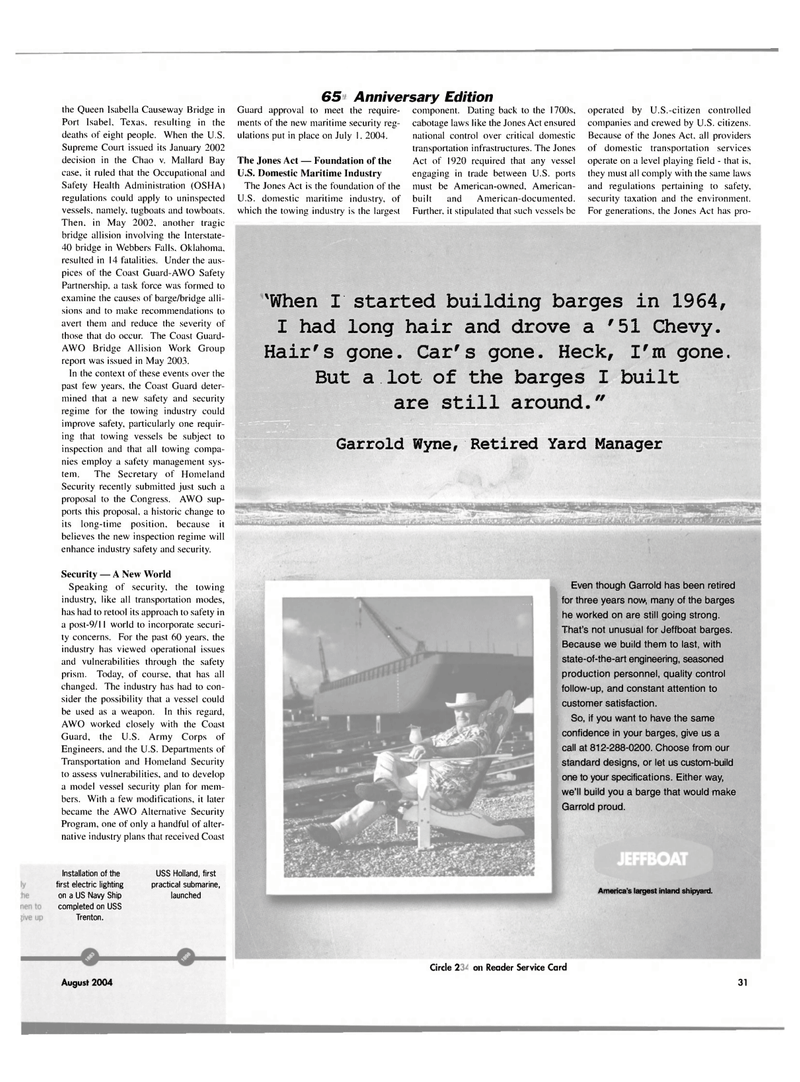
Page 31: of Maritime Reporter Magazine (August 2004)
65th Anniversary Edition
Read this page in Pdf, Flash or Html5 edition of August 2004 Maritime Reporter Magazine
the Queen Isabella Causeway Bridge in
Port Isabel, Texas, resulting in the deaths of eight people. When the U.S.
Supreme Court issued its January 2002 decision in the Chao v. Mallard Bay case, it ruled that the Occupational and
Safety Health Administration (OSHA) regulations could apply to uninspected vessels, namely, tugboats and towboats.
Then, in May 2002, another tragic bridge allision involving the Interstate- 40 bridge in Webbers Falls. Oklahoma, resulted in 14 fatalities. Under the aus- pices of the Coast Guard-AWO Safety
Partnership, a task force was formed to examine the causes of barge/bridge alli- sions and to make recommendations to avert them and reduce the severity of those that do occur. The Coast Guard-
AWO Bridge Allision Work Group report was issued in May 2003.
In the context of these events over the past few years, the Coast Guard deter- mined that a new safety and security regime for the towing industry could improve safety, particularly one requir- ing that towing vessels be subject to inspection and that all towing compa- nies employ a safety management sys- tem. The Secretary of Homeland
Security recently submitted just such a proposal to the Congress. AWO sup- ports this proposal, a historic change to its long-time position, because it believes the new inspection regime will enhance industry safety and security.
Security — A New World
Speaking of security, the towing industry, like all transportation modes, has had to retool its approach to safety in a post-9/11 world to incorporate securi- ty concerns. For the past 60 years, the industry has viewed operational issues and vulnerabilities through the safety prism. Today, of course, that has all changed. The industry has had to con- sider the possibility that a vessel could be used as a weapon. In this regard,
AWO worked closely with the Coast
Guard, the U.S. Army Corps of
Engineers, and the U.S. Departments of
Transportation and Homeland Security to assess vulnerabilities, and to develop a model vessel security plan for mem- bers. With a few modifications, it later became the AWO Alternative Security
Program, one of only a handful of alter- native industry plans that received Coast 65th Anniversary Edition
Installation of the first electric lighting on a US Navy Ship completed on USS
Trenton.
USS Holland, first practical submarine, launched
Guard approval to meet the require- ments of the new maritime security reg- ulations put in place on July 1, 2004.
The Jones Act — Foundation of the
U.S. Domestic Maritime Industry
The Jones Act is the foundation of the
U.S. domestic maritime industry, of which the towing industry is the largest component. Dating back to the 1700s, cabotage laws like the Jones Act ensured national control over critical domestic transportation infrastructures. The Jones
Act of 1920 required that any vessel engaging in trade between U.S. ports must be American-owned. American- built and American-documented.
Further, it stipulated that such vessels be operated by U.S.-citizen controlled companies and crewed by U.S. citizens.
Because of the Jones Act, all providers of domestic transportation services operate on a level playing field - that is, they must all comply with the same laws and regulations pertaining to safety, security taxation and the environment.
For generations, the Jones Act has pro- 'When I started building barges in 1964,
I had long hair and drove a '51 Chevy.
Hair's gone. Car's gone. Heck, I'm gone.
But a lot of the barges I built are still around."
Garrold Wyne, Retired Yard Manager
Even though Garrold has been retired for three years now, many of the barges he worked on are still going strong.
That's not unusual for Jeffboat barges.
Because we build them to last, with state-of-the-art engineering, seasoned production personnel, quality control follow-up, and constant attention to customer satisfaction.
So, if you want to have the same confidence in your barges, give us a call at 812-288-0200. Choose from our standard designs, or let us custom-build one to your specifications. Either way, we'll build you a barge that would make
Garrold proud.
America's largest inland shipyard.
G- Circle 220 on Reader Service Card
August 2004 31

 30
30

 32
32
